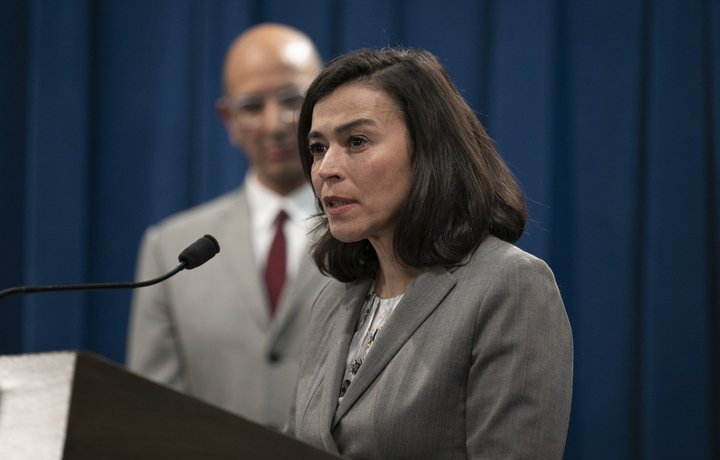
Dr. Sonia Angell, Director of California Department of Public Health, at a press conference in the state capitol following the first COVID-19 death in California on March 4, 2020. Angell has just announced that she is resigning from her post. Photo by Annie Wernikoff for CalMatters.
###
Gov. Gavin Newsom today refused to say the sudden resignation of his top public health officer was because of a series of technical glitches that led to a statewide underreporting of coronavirus cases, except to acknowledge the department was aware of the issue days before informing the governor and his executive team.
Though Newsom wouldn’t cite the data glitch as the sole reason for Sunday’s resignation of Dr. Sonia Angell, director of the state Department of Public Health, the governor said it was appropriate for him to accept her resignation. The speed of the episode highlights the enormous pressure Newsom is under to steer the state through the pandemic.
“We’re all accountable in our respective roles for what happens underneath us,” Newsom said.
The underreporting of coronavirus cases is significant because that data is used to determine how the state and counties should respond to the pandemic — shut down businesses when confirmed cases rise or reopen the economy as cases fall. Counties rely on testing data to investigate cases and conduct contact tracing. And for many families, the data influences how long it will take schools to resume in-person teaching.
Sharing news…I’m stepping down as @CAPublicHealth Director & State #PublicHealth Officer. What an honor to have served #California & @GavinNewsom through this #COVID19 #pandemic, where #science & #equity guide decisions. #CA flattened the curve before, and will do it again!
— Sonia Angell (@DrSoniaAngell) August 10, 2020
Last week, Dr. Mark Ghaly, secretary of the state’s Health and Human Services Agency, revealed the discovery of discrepancies in the state’s electronic reporting system, which feeds case information from test labs to state and local public health departments.
Specifically, the data was delayed by a server outage along with the state’s failure to renew a service from Quest Labs, a commercial lab used by coronavirus testing sites across California. The certification lapse meant the state didn’t receive data from Quest Labs for five days at the start of the month, leading to a backlog of 295,000 lab reports, the majority of which were COVID-19 tests.
State health officials noted, however, that hospitalization data, which continues to trend downward, was not affected by the case reporting error.
Still, Newsom, who has faced mounting criticism from all sides in his response to the pandemic, took responsibility for the recent data glitch and the ensuing confusion that followed. Though California won early praise this spring for minimizing the virus’s spread, the state began to backslide over the summer as Newsom allowed counties to reopen bars as well as in-door dining at restaurants.
“At the end of the day, the buck stops with me,” Newsom said. “I’m accountable.”
California has cleared up its backlog but is working to make sure state records match up with the dates the test results were confirmed. While the state says the test data backlog started around July 25, some counties are reporting the backlog could go back weeks earlier.
Santa Clara County’s Public Health Department, for example, reported 751 new cases. “This number includes a combination of positive tests from as far back as July 8 but most are from the last week,” the department stated today.
Dr. Angell’s departure follows the June resignation of Dr. Charity Dean, the No. 2 in command at the state public health department. It also comes as a number of other county health officers have quit their jobs in face of growing public pressure and in some cases even threats.
In response to Angell’s resignation, Ghaly announced that Sandra Shewry, vice president of external engagement for the California Health Care Foundation, and Dr. Erica Pan, who was recently appointed state epidemiologist, will help fill her role.
Newsom added the state is also looking for a long-term software solution to help build capacity for the state’s test reporting system.
Also today, Newsom said California can’t afford to participate in President Trump’s unemployment stimulus plan, which calls for states to chip in $100 out of a $400-a-week benefit since a federal weekly $600 boost expired July 25.
The governor said doing so would cost the state $700 million a week and there’s money available given the state faces a staggering $54 billion deficit. Newsom said the majority of the state’s aid from the federal Coronavirus Aid, Relief and Economic Security (CARES) act has already been spent or allocated.
“There is no money sitting in the piggy bank,” he said.
###
CALmatters.org is a nonprofit, nonpartisan media venture explaining California policies and politics.
CLICK TO MANAGE